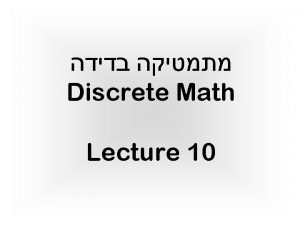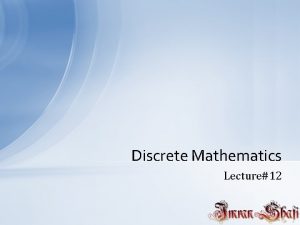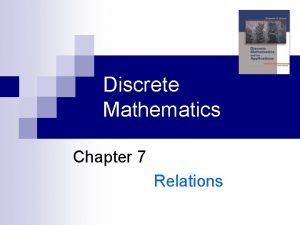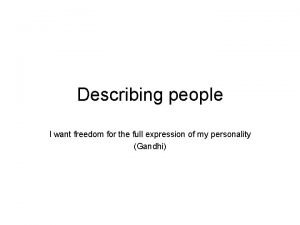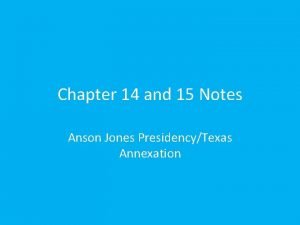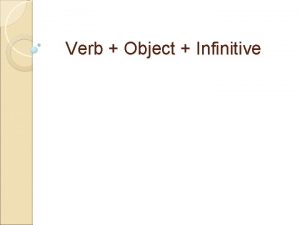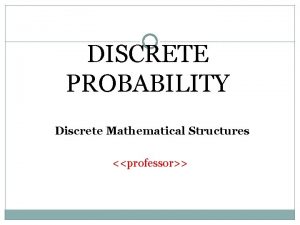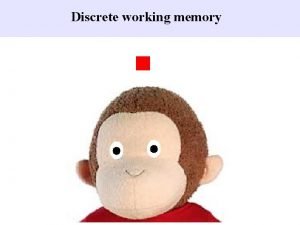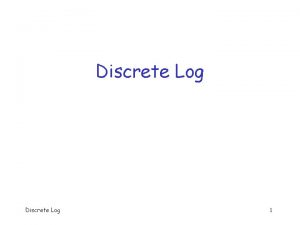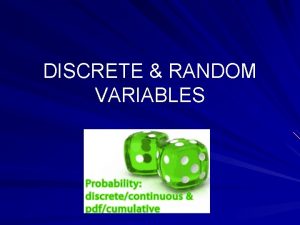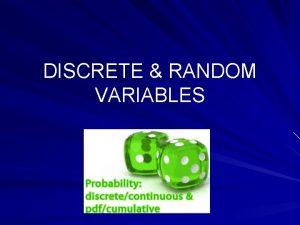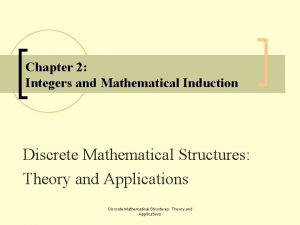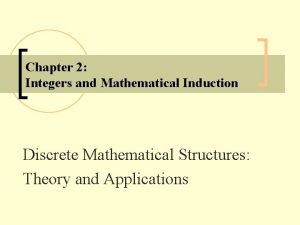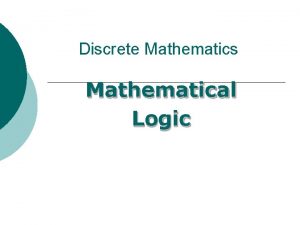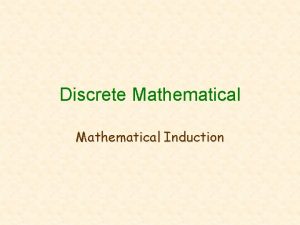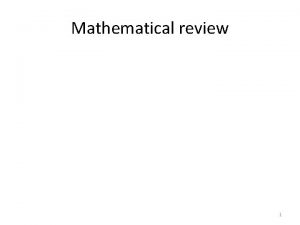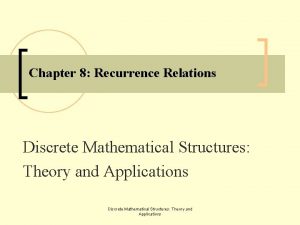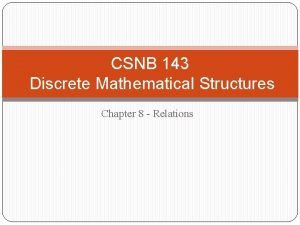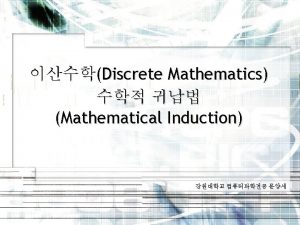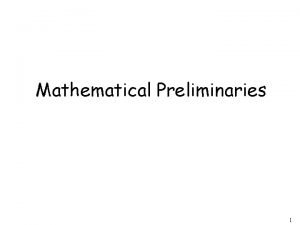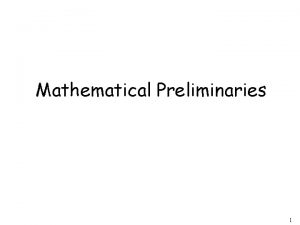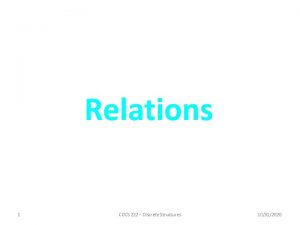Discrete Mathematical Relations Relations If we want to































- Slides: 31

Discrete Mathematical Relations

Relations If we want to describe a relationship between elements of two sets A and B, we can use ordered pairs with their first element taken from A and their second element taken from B. Since this is a relation between two sets, it is called a binary relation. Definition: Let A and B be sets. A binary relation from A to B is a subset of A B. In other words, for a binary relation R we have R A B. We use the notation a. Rb to denote that (a, b) R and a. Rb to denote that (a, b) R. 2

Relations When (a, b) belongs to R, a is said to be related to b by R. Example: Let P be a set of people, C be a set of cars, and D be the relation describing which person drives which car(s). P = {Carl, Suzanne, Peter, Carla}, C = {Mercedes, BMW, tricycle} D = {(Carl, Mercedes), (Suzanne, BMW), (Peter, tricycle)} This means that Carl drives a Mercedes, Suzanne drives a Mercedes and a BMW, Peter drives a tricycle, and Carla does not drive any of these vehicles. 3

Functions as Relations You might remember that a function f from a set A to a set B assigns a unique element of B to each element of A. The graph of f is the set of ordered pairs (a, b) such that b = f(a). Since the graph of f is a subset of A B, it is a relation from A to B. Moreover, for each element a of A, there is exactly one ordered pair in the graph that has a as its first element. 4

Functions as Relations Conversely, if R is a relation from A to B such that every element in A is the first element of exactly one ordered pair of R, then a function can be defined with R as its graph. This is done by assigning to an element a A the unique element b B such that (a, b) R. 5

Relations on a Set Definition: A relation on the set A is a relation from A to A. In other words, a relation on the set A is a subset of A A. Example: Let A = {1, 2, 3, 4}. Which ordered pairs are in the relation R = {(a, b) | a < b} ? 6

Relations on a Set Solution: R = {(1, 2), (1, 3), (1, 4), (2, 3), (2, 4), (3, 4)} 1 2 3 3 4 4 R 1 2 3 4 X X X 4 7

Relations on a Set How many different relations can we define on a set A with n elements? A relation on a set A is a subset of A A. How many elements are in A A ? There are n 2 elements in A A, so how many subsets (= relations on A) does A A have? The number of subsets that we can form out of a set 2 m n with m elements is 2. Therefore, 2 subsets can be formed out of A A. Answer: We can define on A. 2 n 2 different relations 8

Properties of Relations We will now look at some useful ways to classify relations. Definition: A relation R on a set A is called reflexive if (a, a) R for every element a A. Are the following relations on {1, 2, 3, 4} reflexive? R = {(1, 1), (1, 2), (2, 3), (3, 3), (4, 4)} No. R = {(1, 1), (2, 2), (2, 3), (3, 3), (4, 4)} Yes. R = {(1, 1), (2, 2), (3, 3)} No. Definition: A relation on a set A is called irreflexive if (a, a) R for every element a A. 9

Properties of Relations Definitions: A relation R on a set A is called symmetric if (b, a) R whenever (a, b) R for all a, b A. A relation R on a set A is called antisymmetric if a = b whenever (a, b) R and (b, a) R. A relation R on a set A is called asymmetric if (a, b) R implies that (b, a) R for all a, b A. 10

Properties of Relations Are the following relations on {1, 2, 3, 4} symmetric, antisymmetric, or asymmetric? R = {(1, 1), (1, 2), (2, 1), (3, 3), (4, 4)} symmetric R = {(1, 1)} sym. and antisym. R = {(1, 3), (3, 2), (2, 1)} antisym. and asym. R = {(4, 4), (3, 3), (1, 4)} antisym. 11

Properties of Relations Definition: A relation R on a set A is called transitive if whenever (a, b) R and (b, c) R, then (a, c) R for a, b, c A. Are the following relations on {1, 2, 3, 4} transitive? R = {(1, 1), (1, 2), (2, 1), (3, 3)} Yes. R = {(1, 3), (3, 2), (2, 1)} No. R = {(2, 4), (4, 3), (2, 3), (4, 1)} No. 12

Counting Relations Example: How many different reflexive relations can be defined on a set A containing n elements? Solution: Relations on R are subsets of A A, which contains n 2 elements. Therefore, different relations on A can be generated by choosing different subsets out of these n 2 2 n elements, so there are 2 relations. A reflexive relation, however, must contain the n elements (a, a) for every a A. Consequently, we can only choose among n 2 – n = n(n – 1) elements to generate reflexive relations, so there are 2 n(n – 1) of them. 13

Monday 30/12/2013 A relation R on a set A is called reflexive if (a, a) R for every element a A irreflexive if (a, a) R for every element a A. symmetric if (b, a) R whenever (a, b) R for all a, b A antisymmetric if a = b whenever (a, b) R and (b, a) R (a, b. . . )ﻣﺘﺴﺎﻭﻳﺘﺎﻥ ﻛﻠﻤﺎ asymmetric if (a, b) R implies that (b, a) R for all a, b A transitive if whenever (a, b) R and (b, c) R, then (a, c) R for a, b, c A.

Example 1: • Rdiv ={(a b), if a |b} on A = {1, 2, 3, 4} • Rdiv = {(1, 1), (1, 2), (1, 3), (1, 4), (2, 2), (2, 4), (3, 3), (4, 4)} • Is Rdiv anti-symmetric? • Answer: Yes. There is no (a, b) and (b, a) in R for a ≠ b. Example 2: • R≠ on A={1, 2, 3, 4}, such that a R≠ b if and only if a ≠ b. • Is R≠ asymmetric ? • R≠={(1, 2), (1, 3), (1, 4), (2, 1), (2, 3), (2, 4), (3, 1), (3, 2), (3, 4), (4, 1), (4, 2), (4, 3)} • Answer: No. It is not anti-symmetric since (1, 2) R and (2, 1) R but 1≠ 2.

Representing Relations We already know different ways of representing relations. We will now take a closer look at two ways of representation: Zero-one matrices and directed graphs. If R is a relation from A = {a 1, a 2, …, am} to B = {b 1, b 2, …, bn}, then R can be represented by the zeroone matrix MR = [mij] with mij = 1, if (ai, bj) R, and mij = 0, if (ai, bj) R. Note that for creating this matrix we first need to list the elements in A and B in a particular, but arbitrary order. (. ﻭﻟﻜﻦ ﻏﻴﺮ ﻣﺤﺪﺩ ، )ﻓﻲ ﺗﺮﺗﻴﺐ ﻣﻌﻴﻦ 16

Representing Relations Example: How can we represent the relation R = {(2, 1), (3, 2)} as a zero-one matrix? Solution: The matrix MR is given by 17

Representing Relations What do we know about the matrices representing a relation on a set (a relation from A to A) ? They are square matrices. What do we know about matrices representing reflexive relations? All the elements on the diagonal of such matrices Mref must be 1 s. 18

Representing Relations What do we know about the matrices representing symmetric relations? These matrices are symmetric, that is, MR = (MR)t. symmetric matrix, symmetric relation. non-symmetric matrix, non-symmetric relation. 19

Representing Relations The Boolean operations join and meet (you remember? ) can be used to determine the matrices representing the union and the intersection of two relations, respectively. To obtain the join of two zero-one matrices, we apply the Boolean “or” function to all corresponding elements in the matrices. To obtain the meet of two zero-one matrices, we apply the Boolean “and” function to all corresponding elements in the matrices. 20

Representing Relations Example: Let the relations R and S be represented by the matrices What are the matrices representing R S and R S? Solution: These matrices are given by 21

Representing Relations Using Matrices Example: How can we represent the relation R = {(2, 1), (3, 2)} as a zero-one matrix? Solution: The matrix MR is given by 22

Representing Relations Using Matrices Example: Let the relations R and S be represented by the matrices What are the matrices representing R S and R S? Solution: These matrices are given by 23

Representing Relations Using Matrices Example: Find the matrix representing R 2, where the matrix representing R is given by Solution: The matrix for R 2 is given by 24

Representing Relations Using Digraphs Definition: A directed graph, or digraph, consists of a set V of vertices (or nodes) together with a set E of ordered pairs of elements of V called edges (or arcs). The vertex a is called the initial vertex of the edge (a, b), and the vertex b is called the terminal vertex of this edge. We can use arrows to display graphs. 25

Representing Relations Using Digraphs Example: Display the digraph with V = {a, b, c, d}, E = {(a, b), (a, d), (b, b), (b, d), (c, a), (c, b), (d, b)}. a d b c An edge of the form (b, b) is called a loop. 26

Representing Relations Using Digraphs Obviously, we can represent any relation R on a set A by the digraph with A as its vertices and all pairs (a, b) R as its edges. Vice versa, any digraph with vertices V and edges E can be represented by a relation on V containing all the pairs in E. This one-to-one correspondence between relations and digraphs means that any statement about relations also applies to digraphs, and vice versa. 27

Equivalence Relations Equivalence relations are used to relate objects that are similar in some way. Definition: A relation on a set A is called an equivalence relation if it is reflexive, symmetric, and transitive. Two elements that are related by an equivalence relation R are called equivalent. 28

Equivalence Relations Since R is symmetric, a is equivalent to b whenever b is equivalent to a. Since R is reflexive, every element is equivalent to itself. Since R is transitive, if a and b are equivalent and b and c are equivalent, then a and c are equivalent. Obviously, these three properties are necessary for a reasonable definition of equivalence. 29

Equivalence Relations Example: Suppose that R is the relation on the set of strings that consist of English letters such that a. Rb if and only if l(a) = l(b), where l(x) is the length of the string x. Is R an equivalence relation? Solution: • R is reflexive, because l(a) = l(a) and therefore a. Ra for any string a. • R is symmetric, because if l(a) = l(b) then l(b) = l(a), so if a. Rb then b. Ra. • R is transitive, because if l(a) = l(b) and l(b) = l(c), then l(a) = l(c), so a. Rb and b. Rc implies a. Rc. R is an equivalence relation. 30

Equivalence Classes Another example: Let R be the relation {(a, b) | a b (mod 3)} on the set of integers. Is R an equivalence relation? Yes, R is reflexive, symmetric, and transitive. What are the equivalence classes of R ? {{…, -6, -3, 0, 3, 6, …}, {…, -5, -2, 1, 4, 7, …}, {…, -4, -1, 2, 5, 8, …}} 31
 Non mathematical economics
Non mathematical economics Binary relation in discrete mathematics
Binary relation in discrete mathematics Converse of a relation
Converse of a relation Define antisymmetric relation
Define antisymmetric relation Employee relations in public relations
Employee relations in public relations What did kat get from glimmer's body?
What did kat get from glimmer's body? Dhondu wanted to buy a
Dhondu wanted to buy a Glittering generalities advertising
Glittering generalities advertising Describe morcerf as a father and a husband
Describe morcerf as a father and a husband Percy jackson read aloud chapter 12
Percy jackson read aloud chapter 12 I want to hold your hand analysis
I want to hold your hand analysis A christmas carol ignorance and want
A christmas carol ignorance and want I want freedom
I want freedom Somebody once asked could i spare some change for gas
Somebody once asked could i spare some change for gas I want a wife satire analysis
I want a wife satire analysis If you want joy real joy wonderful joy
If you want joy real joy wonderful joy I want them to waterski across the surface of a poem
I want them to waterski across the surface of a poem Voegwoorde
Voegwoorde Signing naturally i wanna be different answers
Signing naturally i wanna be different answers Did anson jones want annexation?
Did anson jones want annexation? Cow
Cow What your name reported speech
What your name reported speech Krowehom
Krowehom Isaac newton one of the greatest scientists was born
Isaac newton one of the greatest scientists was born Simple past
Simple past Want in simple past
Want in simple past Want what
Want what Object and infinitive
Object and infinitive It is evident that want peace
It is evident that want peace Unit 5 what do you want to do
Unit 5 what do you want to do I want to learn examples
I want to learn examples See past simple
See past simple

